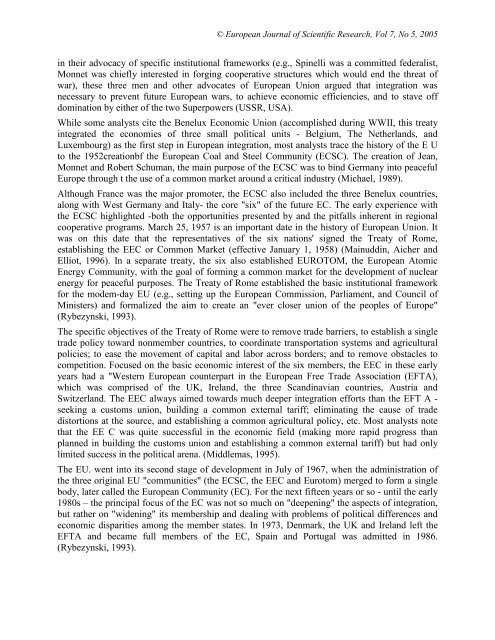European Journal of Scientific Research (ISSN: 1450 ... - EuroJournals
European Journal of Scientific Research (ISSN: 1450 ... - EuroJournals
European Journal of Scientific Research (ISSN: 1450 ... - EuroJournals
Create successful ePaper yourself
Turn your PDF publications into a flip-book with our unique Google optimized e-Paper software.
© <strong>European</strong> <strong>Journal</strong> <strong>of</strong> <strong>Scientific</strong> <strong>Research</strong>, Vol 7, No 5, 2005<br />
in their advocacy <strong>of</strong> specific institutional frameworks (e.g., Spinelli was a committed federalist,<br />
Monnet was chiefly interested in forging cooperative structures which would end the threat <strong>of</strong><br />
war), these three men and other advocates <strong>of</strong> <strong>European</strong> Union argued that integration was<br />
necessary to prevent future <strong>European</strong> wars, to achieve economic efficiencies, and to stave <strong>of</strong>f<br />
domination by either <strong>of</strong> the two Superpowers (USSR, USA).<br />
While some analysts cite the Benelux Economic Union (accomplished during WWII, this treaty<br />
integrated the economies <strong>of</strong> three small political units - Belgium, The Netherlands, and<br />
Luxembourg) as the first step in <strong>European</strong> integration, most analysts trace the history <strong>of</strong> the E U<br />
to the 1952creationbf the <strong>European</strong> Coal and Steel Community (ECSC). The creation <strong>of</strong> Jean,<br />
Monnet and Robert Schuman, the main purpose <strong>of</strong> the ECSC was to bind Germany into peaceful<br />
Europe through t the use <strong>of</strong> a common market around a critical industry (Michael, 1989).<br />
Although France was the major promoter, the ECSC also included the three Benelux countries,<br />
along with West Germany and Italy- the core "six" <strong>of</strong> the future EC. The early experience with<br />
the ECSC highlighted -both the opportunities presented by and the pitfalls inherent in regional<br />
cooperative programs. March 25, 1957 is an important date in the history <strong>of</strong> <strong>European</strong> Union. It<br />
was on this date that the representatives <strong>of</strong> the six nations' signed the Treaty <strong>of</strong> Rome,<br />
establishing the EEC or Common Market (effective January 1, 1958) (Mainuddin, Aicher and<br />
Elliot, 1996). In a separate treaty, the six also established EUROTOM, the <strong>European</strong> Atomic<br />
Energy Community, with the goal <strong>of</strong> forming a common market for the development <strong>of</strong> nuclear<br />
energy for peaceful purposes. The Treaty <strong>of</strong> Rome established the basic institutional framework<br />
for the modem-day EU (e.g., setting up the <strong>European</strong> Commission, Parliament, and Council <strong>of</strong><br />
Ministers) and formalized the aim to create an "ever closer union <strong>of</strong> the peoples <strong>of</strong> Europe"<br />
(Rybezynski, 1993).<br />
The specific objectives <strong>of</strong> the Treaty <strong>of</strong> Rome were to remove trade barriers, to establish a single<br />
trade policy toward nonmember countries, to coordinate transportation systems and agricultural<br />
policies; to ease the movement <strong>of</strong> capital and labor across borders; and to remove obstacles to<br />
competition. Focused on the basic economic interest <strong>of</strong> the six members, the EEC in these early<br />
years had a "Western <strong>European</strong> counterpart in the <strong>European</strong> Free Trade Association (EFTA),<br />
which was comprised <strong>of</strong> the UK, Ireland, the three Scandinavian countries, Austria and<br />
Switzerland. The EEC always aimed towards much deeper integration efforts than the EFT A -<br />
seeking a customs union, building a common external tariff; eliminating the cause <strong>of</strong> trade<br />
distortions at the source, and establishing a common agricultural policy, etc. Most analysts note<br />
that the EE C was quite successful in the economic field (making more rapid progress than<br />
planned in building the customs union and establishing a common external tariff) but had only<br />
limited success in the political arena. (Middlemas, 1995).<br />
The EU. went into its second stage <strong>of</strong> development in July <strong>of</strong> 1967, when the administration <strong>of</strong><br />
the three original EU "communities" (the ECSC, the EEC and Eurotom) merged to form a single<br />
body, later called the <strong>European</strong> Community (EC). For the next fifteen years or so - until the early<br />
1980s – the principal focus <strong>of</strong> the EC was not so much on "deepening" the aspects <strong>of</strong> integration,<br />
but rather on "widening" its membership and dealing with problems <strong>of</strong> political differences and<br />
economic disparities among the member states. In 1973, Denmark, the UK and Ireland left the<br />
EFTA and became full members <strong>of</strong> the EC, Spain and Portugal was admitted in 1986.<br />
(Rybezynski, 1993).

















